It's a top-selling model, within the seven-seater SUV segment (5+2 to be more precise), and if there's one thing it needed it was higher-powered diesel versions. It's not that the 130bhp dCi engine is always insufficient, but for certain uses it was just a bit too little. Now Nissan is updating the X-Trail with the 2.0 dCi (M9R) engine with an output of 177 hp, which will take one in four sales of this model. They can be ordered now, from 30,750 euros (X-Tronic 4×2 Acenta) including the promotional discount, although they will not be in dealerships until January.
Homologa 5.6-6 l/100 km of diesel, optimistic, as is usual.
The new range-topper arrives in three versions: 4×2 automatic, 4×4 manual and 4×4 automatic. Automatic means X-Tronic, which is what Nissan calls its continuously variable transmission or CVT. There are no manual 4×2 versions so as not to overlap with the 1.6 dCi. And why not the 1.6 dCi Biturbo, with similar power? The answer from product managers has been that customers appreciate having the higher displacement more, although a question of engineering timing was also mentioned as having something to do with it. There are no engine badges, nor is "2.0" anywhere to be seen.
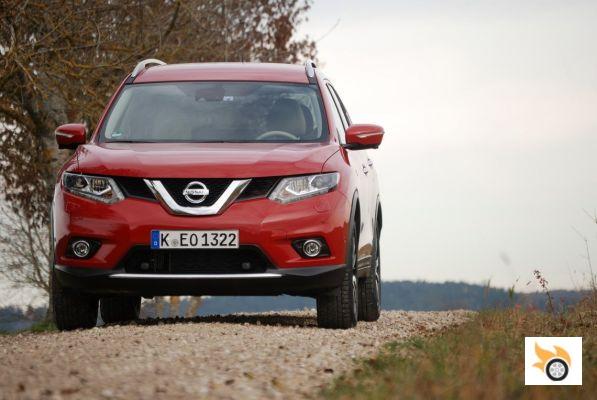
In any case, the 177bhp engine puts the X-Trail at a performance level equal to or better than the 1.6 DIG-T petrol engine with 163bhp. The price difference between the 1.6 dCi and the 2.0 dCi, for the same version, is 1,500 euros. This is a quite reasonable increase, as it's not just a simple upgrade, it's more engine. Acceleration 0-100 km/h goes from 9.4 to 10 seconds, depending on the gearbox/traction combination. The rest of the car remains as it was, there are no new features or equipment or aesthetics.
For the first time the X-Tronic transmission can be combined with all-wheel drive, but only with the new engine.
What does the 177 hp engine bring? On the one hand it means an extra 60 Nm of maximum torque, i.e. 380 Nm available at 2,000 rpm. Maximum power is delivered at 3,750 RPM. That's up to 95 kg more, depending on equipment, alloy wheels, etc. In the presentation photos we see 19-inch Continental WinterContact 3 tyres, for winter use and M+S marking. In the area where we moved they are mandatory at this time of year. In Spain these tyres will not be fitted unless the owner expressly requests it.
We tested the two all-wheel drive and 177 hp versions, the manual and the automatic, in totally varied conditions of use: urban area, Autobahn, conventional roads and a quarry where there was mud everywhere. The brand prepared an unusual route, where the cars became dirtier than they will ever be again in the rest of their life. The original paint colour became the least important thing.
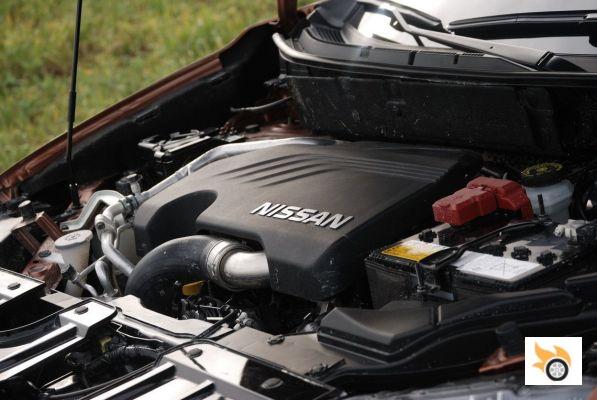
Before arriving at such a succulent place, we drove in a civilized and normal way on Swiss and German roads, within the law, with the manual gearbox version. As with the lower-powered versions, the engine revs are matched to the gears to avoid jerks and a lack of smoothness. Even the clumsiest driver will feel a pr0 shifting gears.
This level of power used to be offered by a V6, or a twin-turbo four-cylinder. Now a single turbo is enough
The feel of the gear lever is exactly the same, the only thing that is different is the development of the sixth gear when compared to the 130 hp dCi. With the 177bhp engine the X-Trail is still not a rocket ship, but it has more power available and has an extra point of acceleration in situations where the 1.6 dCi is just short of what the 1.6 dCi needs. It's power for overtaking or driving at a good pace, not for cornering.
Part of the trip was spent on secondary roads with plenty of curves, those that we like to pistonudos, and there the X-Trail does not feel comfortable. The power steering disconnects the driver almost completely from the road, the comfort-focused suspension causes swaying and it's a bit difficult to guess what the car is doing at any given moment. Occasionally it can feel as realistic as a game console steering wheel. It's supposed to be what customers in the D-SUV segment are asking for, a big, comfortable car. Do they also ask for over-assisted steering?
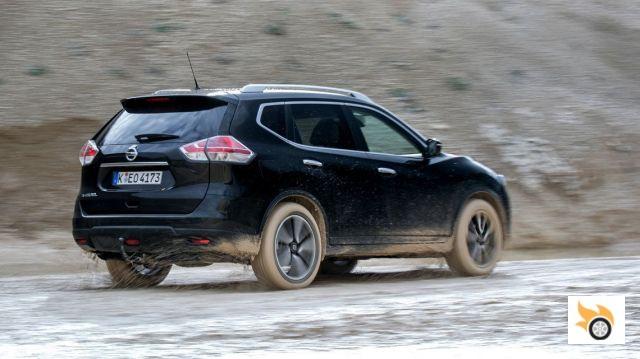
If there isn't that much of a curve, to tell the truth, the X-Trail is a pleasant car, it filters out the imperfections of the road and has a big saloon-like ride (in a straight line, mind you). One of the peculiarities of this car is the "active chassis control", whose functions include selective braking to reduce pitching movement when the asphalt undulates. It intervenes very little and is almost imperceptible, but the effect is noticeable if you concentrate.
In other words, this car is the ideological replacement for what used to be a 5+2 MPV. Those who buy it look at the design, value its interior capacity and the versatility of the seven seats. They are arranged like in a theatre, the second row higher than the first, and the third a little higher. It is worth remembering at this point that the third row is for occasional use or to carry children. The second row seats can be adjusted to leave more space, or to go very reclined and take a nap.
On the road the 2.0 dCi engine does not bring a radical novelty in the category. It is a diesel with strength, quiet ride, which withstands the irregularities of the terrain without constantly asking for a gear change. With the manual gearbox, consumption stood at 7.3 l/100 km when we arrived at the interesting place of the presentation, a heavy mining quarry, where our crossover was going to have fun while the huge trucks were working. If pigs enjoy mud, that's paradise for them, I've never seen more mud together in my life. I started rubbing my hands together, and not just because of the cold.
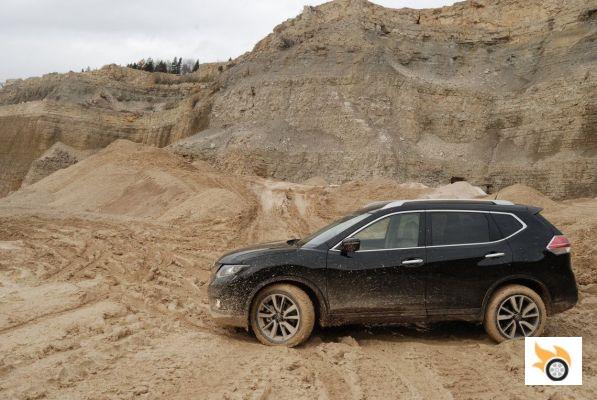
Once on site, the Nissan organisers were very insistent that we didn't exceed 30 km/h in the whole area. Sometimes I have occasional memory lapses, and at some points that pace was doubled. It's not just that the disciplined Germans who were working could tell us off, it's that on a dirt track with undulations and imperfections the suspension of the X-Trail bumps relatively easily, because it's more designed for tarmac than dirt. Logical.
Different skill tests were organized, each one more hilarious, like putting the car on three wheels with a bucket of water on the roof trying not to spill the water, raising the biggest wave in a puddle, disassemble half a car to find a key or pull a trailer on a circuit of cones having the windows covered. That last one we did with a trick, the X-Trail has four cameras that simulate an aerial view. The tricky part was reversing with a trailer, anyone who has an E licence will know what I'm talking about.
Speaking of towing, with the 2.0 dCi engine the X-trail can pull 2,000 kg with brakes, this with manual gearbox, if you choose the X-Tronic automatic the capacity drops to 1,650 kg.
Leaving aside the recreational part, I must admit that I was very pleasantly surprised by the power of the X-Trail's all-wheel drive system. For some photos I was up to my ankles in mud, and I had doubts that the car would be able to get out without having to ask for a sling and help. It wasn't necessary. The All-Mode 4x4i system has a mode that "locks" the 50:50 power distribution between axles (4×4 LOCK), so, with these wheels, no spot on the muddy track was the slightest problem. With 100% asphalt tyres the result would not have been so good, just look at the difference in tread.
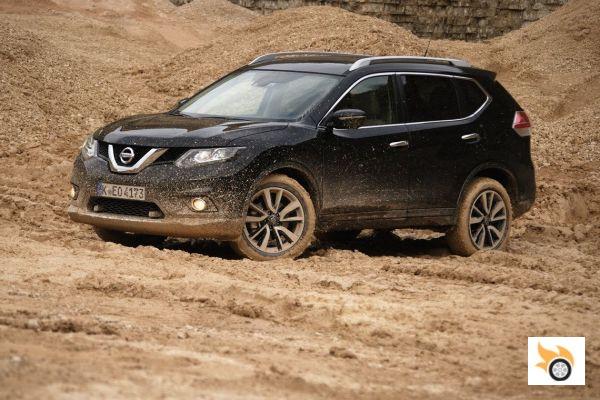
Most of the 4×4 route was done with the automatic gearbox. Occasionally, the car turned out to be a bit clumsy at low speed. Even leaving the gearbox in position "1", which keeps the CVT in short ratios, you had to push the throttle to get it to wake up. After all, the power is there, it's just that it's a system designed more for on-road driving than off-road. The transmission ratio is variable between 2.413 and 0.383, considering that 1 is pure "direct".
Eight years ago I tested the X-Trail (T31) in high alpine, "when the jackdaw flies low it's freezing cold" type cold, with conventional tires and on snow/ice. At the time I really liked the way it went. According to the X-Trail product manager in Spain, Abel Simón, it's basically the same system as back then, but recalibrated in the sense that they're not the same cars in terms of weight, power, etc.
Consumption in 4×4 driving did not fall below 10 l/100 km, which is not high at all.
This car, like almost all of its lineage, is more limited by its angles and ground clearance, as well as the tyres, than by the all-wheel drive system itself. We don't all need to go with triple locking differentials and rigid axles. With the right tyres the X-Trail can move through clay/sticky mud no problem, as long as it doesn't touch the belly, and without having to touch the traction control at all. The car is comfortable in that environment, it doesn't just have kerb-climbing ability.
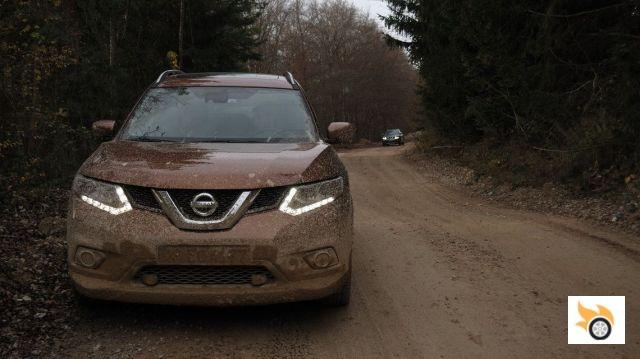
After having put the fine Filipino mud cars, and after getting purple to eat, we returned to Zurich to take the plane. Before leaving the site, the cars received a kärcherazo to avoid problems derived from having swum in mud: at more than 60 km / h everything that has been deposited on the rims can generate brutal vibrations by unbalanced. The cars didn't show any inconvenience of that kind when we left, although it must be said that the parking sensors sometimes went crazy with so much dirt. The cameras get much less dirty.
I can vouch for the X-Trail's comfort as a co-driver, as I was fried on both the outward and return journeys, although extreme tiredness also helps.
Part of the journey was on the Autobahn, where we drove at a comfortable 150-160 km/h without noticing unbearable fuel consumption. Other colleagues claim to have put the needle on the speedometer at more than 200 km/h, but I don't have so much faith in the stability of an SUV in an emergency stop at such a pace. It was a good trot and the plane was leaving at the same time, so... In any case, the official top speed is 204 km/h, with manual gearbox and all-wheel drive.
There's little to say about the automatic gearbox on the motorway. In some situations it will spin at lower revs than the manual, that's the good thing about the variator, and the engine feels more energetic than the 130 hp dCi. There are much better cars for touring, the X-Trail is for cruising. There is still a petrol alternative for those who want it, but it can't be combined with all-wheel drive, only front-wheel drive. By the way, with the 177 hp engine there is no 4×2 manual version, only automatic. Consumption was 6.7 l/100 km on arrival at the airport, explainable by a smaller amount of secondary road, it was a very direct journey.
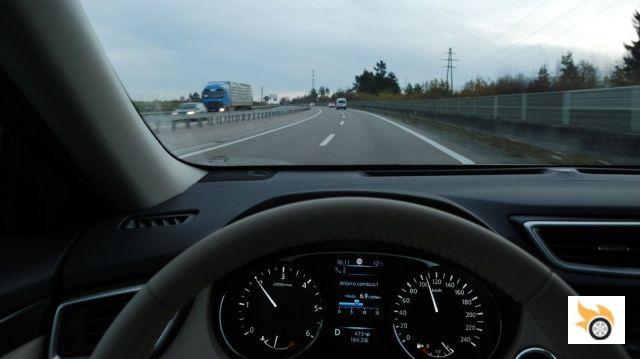
In short, Nissan has done the right thing by putting the big engine in this car, it was needed, we had asked the journalists, customers and common sense. From now on, whoever wants more muscle knows, it's 1,500 euros more for the same version. It's too early to talk about consumption differences, but I bet there are situations where the 2.0 dCi engine consumes less than the 1.6 dCi, as the Americans say, there's no replacement for displacement.
PS: I am aware that some owners of X-Trail (T32) with all-wheel drive have complained about annoying vibrations in the rear axle when driving in 4×4 AUTO mode, at more than 100 km/h, uphill, and in 6th gear. I was unable to reproduce the problem, and it didn't happen to me with an X-Trail 1.6 dCi tested a few months ago either. Discussing this problem with people at Nissan, they said they were aware of it.

























